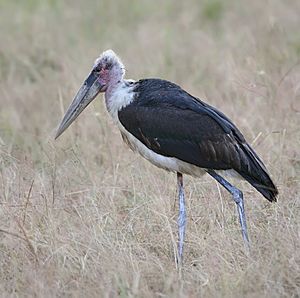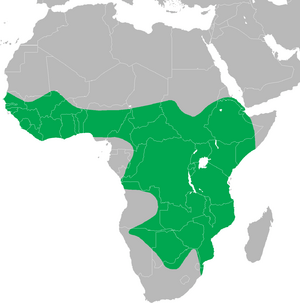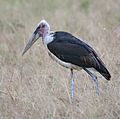Marabou Stork facts for kids
Quick facts for kids Marabou stork |
|
|---|---|
 |
|
| Marabou stork in the Mikumi National Park, Tanzania | |
| Conservation status | |
| Scientific classification | |
| Kingdom: | |
| Phylum: | |
| Class: | |
| Order: | |
| Family: | |
| Genus: |
Leptoptilos
|
| Species: |
L. crumeniferus
|
| Binomial name | |
| Leptoptilos crumeniferus Lesson, 1831
|
|
 |
|
The Marabou Stork (Leptoptilos crumeniferus) is a very large wading bird. It belongs to the stork family, called Ciconiidae. This stork lives in Africa, south of the Sahara desert. You can find it in both wet and dry places, often close to where people live, especially near garbage dumps. Some people call it the "Undertaker Bird." This is because of how it looks from behind: its wings and back look like a cloak, it has thin white legs, and sometimes a big white fluffy part that looks like hair.
Contents
Meet the Marabou Stork: A Giant Bird
The marabou stork is a truly huge bird. Some very large ones can stand as tall as 152 cm (60 in). They can also weigh up to 9 kg (20 lb). These storks are known for their amazing wingspan. Some have wings that spread out to 3.7 m (12 ft). This makes them one of the birds with the largest wingspans in the world.
Most marabou storks have a wingspan between 225–287 cm (7–9 ft). Their typical weight is 4.5–8 kg (9.9–17.6 lb). From their bill to their tail, they are usually 120 to 130 cm (47 to 51 in) long. Female storks are generally smaller than males. Their long bills can be from 26.4 to 35 cm (10.4 to 13.8 in) in length. Unlike most storks, the marabou stork flies with its neck pulled back, just like a heron.
You can easily spot a marabou stork because of its huge size. It has a bare head and neck, which are black. Its belly is white. It also has a very large bill. A pink pouch, called a gular sac, hangs from its throat. The name crumenifer(us) means "carrier of a pouch for money." It also has a ruff of feathers around its neck and black legs and wings. Male and female storks look similar. However, young birds are browner and have smaller bills. They take up to four years to become fully grown adults.
Marabou Stork Behavior
Like many storks, the marabou stork likes to live in groups. It also breeds in large colonies. During Africa's dry season, when food is easier to find, they build nests in trees. They usually lay two or three eggs in each nest. These birds can sometimes be quite grumpy!
Marabou storks are not very noisy birds. However, they do make sounds by rattling their bills during courtship displays. This is when they try to attract a mate. They also use their throat sac to make different noises at this time.
Feeding Habits and Diet
The marabou stork is a frequent scavenger. This means it often eats dead animals. Its bare head and neck help it stay clean when it puts its head inside a large dead body. This is similar to how vultures stay clean.
This large and strong bird mostly eats carrion (dead animals), food scraps, and even animal waste. But it will eat almost any animal matter it can swallow if it gets the chance. Sometimes, it eats other birds, like baby quelea birds, pigeons, and even flamingos. During the breeding season, adult storks eat less carrion. They mostly hunt small, live prey. This is because their babies need this kind of fresh food to grow.
Common prey during this time includes fish, frogs, and insects. They also eat eggs, small mammals, and reptiles. This can include baby crocodiles, crocodile eggs, lizards, and snakes. Even though they are known to eat rotten food, these storks sometimes wash their food in water. This helps to remove dirt.
When eating dead animals, marabou storks often follow vultures. Vultures have hooked bills that are better for tearing through meat. The storks might wait for vultures to drop a piece of meat. They might also steal meat directly from a vulture. Or they wait until the vultures are finished eating. Like vultures, marabou storks help clean up nature. They do this by eating dead animals and waste.
More and more, marabous are relying on human garbage for food. Hundreds of these huge birds can be seen around African dumps. They also wait for handouts in cities. Marabous that eat human garbage have been seen swallowing almost anything. This can include shoes and even pieces of metal. Storks that are used to getting food from humans have been known to get angry if they are refused food.
Reproduction and Life Cycle
Marabou storks breed in colonies, which are large groups. They start breeding during the dry season. The female stork lays two to three eggs in a small nest made of sticks. The eggs hatch after about 30 days. Their young storks become old enough to have their own babies when they are about 4 years old. In zoos, a marabou stork can live for 41 years. In the wild, they usually live for about 25 years.
Marabou Stork and Humans
Marabou down, which are soft feathers, are often used to decorate clothes and hats. They are also used to make fishing lures. Sometimes, turkey down or other feathers are used instead of real marabou feathers for these decorations.
Images for kids
-
A Marabou stork and Griffon vultures (G. fulvus) scavenging in the Masai Mara, Kenya
-
spreading wings, Uganda
See also
 In Spanish: Marabú africano para niños
In Spanish: Marabú africano para niños















